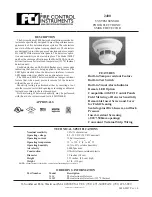
30309460
Issue 1.06
Features
Providing for connections to remote indicators.
A magnet test available.
Standard: UL268
Description
DC-M9102 Conventional Photoelectric Smoke Detector (the
detector) is a new-generation product by building in a
microprocessor, embedding a solid fire analyzing program, and
performing effectively and efficiently.
Checking a fire alarm signal, the detector will send it to a fire alarm
control panel (FACP) or addressable zone monitor unit by means of
current changes. The detector indicates its fire condition by turning
on fire LED and keeping the LED on until it is reset.
Using infrared scattering technology, with an innovative chamber,
the detector receives very weak infrared light under normal
smokeless condition. If smoke particles enter the chamber, the
received light signal will increase by scattering. When smoke
density reaches certain density, the detector will output fire signal. In
order to reduce interference and power consumption, the emitting
circuit works in pulse mode to prolong the life of IR LED.
Connection and cabling
The detector connects with our UL certified GST-M200 FACP and
I-M9300 Module. DB-M01 base shown in Fig. 2 is used together.
5
45
75
Cable Entry
Mounting
Hole
Fig. 1 Fig. 2
Please install the base according to the following steps:
1)
Locate the mounting holes on the rubber seal of the base
according to the holes on the electrical junction box, and
punch the holes with a screwdriver.
2)
Count the number of cables needed and punch correct
number of holes with a screwdriver on the rubber seal at the
cable entry position. Thread the cables through the cable
entry holes.
3)
Install the base onto the junction box with screws.
Warning: Do not punch mounting holes and cable entry holes
bigger than needed. Do not punch more holes than needed.
There are four terminals with number on the base.
“1” is connected
with output anode of I-M9300 module;
“2” is used as output,
connected with anode of next detector (Terminal 1) and also
connected with anode of remote indicator;
“3” is connected with
output cathode of I-M9300 module or the cathode of the power supply;
“4” connects with the cathode of remote indicator. Connect 4.7k/1w
resistor to terminal 2 and 3 of the base. Maximum 15 detectors can
be connected to the output circuit of I-M9300 The system connection
is shown in Fig. 3.
Remote Indicator
O
-
O
+
I-M9300
Conventional Detector
4.7
k
Ω
Res
istor
Remote Indicator
Conventional Detector
Fig. 3
Recommended Wiring
1.0mm
2
or above fire cable for all terminals laid through metal conduit
or flame proof conduit, subject to local codes.
Note: Different color cables are used to avoid wiring mistake.
Installation
Refer to
D Series Detector Application Bulletin
for additional installation
instructions
.
Fix the base with two taping screws. Then align A (Fig.1) on the
bottom of the detector to B (Fig.2) of the base, and rotate the
detector clockwise to mark C.
Mounting of the detector is shown in Fig.4.
Electrical Box
Conduit
Orientation Base
Detector
54.5mm
Fig. 4
Application
Notes: The alarm current depends on the current limit of the
control panel. 24VDC cannot power the detector directly.
Otherwise the detector will be blown up for lack of current limit
resistor.
Testing
Before testing, please ensure that the detector has been
installed correctly and powered up. After 10 seconds, testing
can begin.
Before testing, notify the proper authorities that the system is
undergoing maintenance and will temporarily be out of service.
Disable the zone or system undergoing maintenance to avoid
unwanted alarms.
All detectors must be tested after installation and periodically
thereafter. Testing methods must satisfy the Authority Having
Jurisdiction (AHJ). Detectors offer maximum performance when
tested and maintained in compliance with NFPA 72. The detector
can be tested in the following way:
Test zone
Fig. 5 Fig. 6
1)
Magnetic test
Magnet test zone is shown in Fig.5. Put the magnet of commission
tool close to the zone of the detector and hold on for a few seconds
until the detector generates alarm.
2)
Smoke test
The Trutest model 300 Aerosol Smoke Detector Tester can be used
DC-M9102
Conventional Photoelectric
Smoke Detector




















